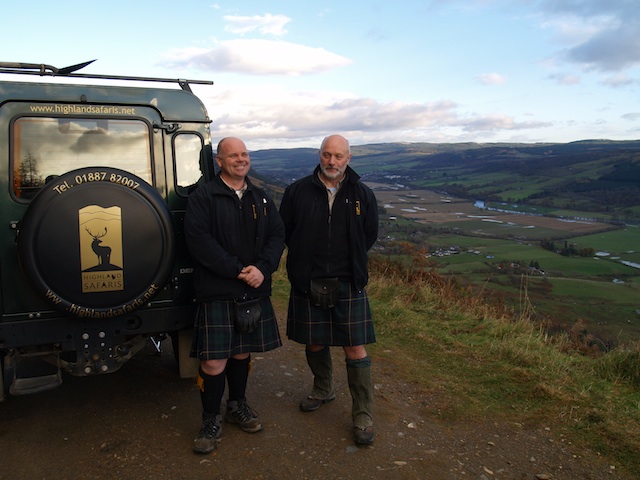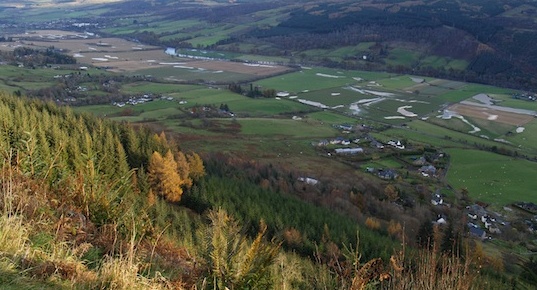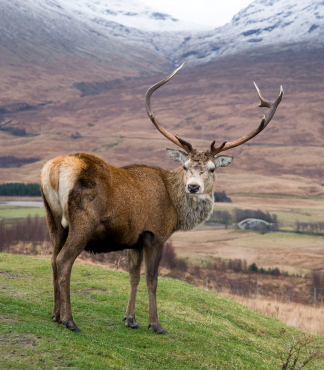
|
|
 |
||||||||||||||||||||
|
|
|||||||||||||||||||||
|
WHISKEY & WILDLIFE Two Unlike Companions Come Together in the Highlands of Scotland The day is wet, chilly and miserable – exactly the kind of weather we’ve been told to expect in November in the Scottish Highlands. But like a true-blue Scot, Andy Reed takes the water from the heavens in stride. After all, it’s the force of water that has shaped the landscape of islands, rugged hills and fertile glens. And it’s the rich and peaty waters that produce the country’s signature drink, whiskey. “We’re about spotting wildlife but we’re also about the history of this area,” says the kilt-clad Reed  as he shifts gears on our 4WD Land Rover, grinding us through the muddy, pot-holed gravel road up Drummond Hill in the lower Highlands. “This road was one of General Wade’s military roads built in 1733 to move English troops up through Scotland.” as he shifts gears on our 4WD Land Rover, grinding us through the muddy, pot-holed gravel road up Drummond Hill in the lower Highlands. “This road was one of General Wade’s military roads built in 1733 to move English troops up through Scotland.”Reed is a ranger/guide with Highland Safaris, an award-winning eco-safari and wildlife tourism company that uses spotting scopes and binoculars to track wildlife, and photographic lenses to make the capture. Located near Aberfeldy, in the district known as the Perthshire Highlands, the area is famous as Scotland’s first "Fairtrade" market town, as well as being the home of author J.K. Rowling of Harry Potter fame. Some consider the highlands region of Scotland to be part of Europe’s last wilderness. The Highland Perthshire region, where Highland Safaris operates, is south of the Great Glen, the massive geological fault line that splits the country into two very distinct parts. The Highlands (both north and south of the Great Glen) encompass Scotland’s most breathtaking scenery – a pristine  landscape of sloping hills blanketed with heather, bracken and forests of birch, larch and Scotch pine. landscape of sloping hills blanketed with heather, bracken and forests of birch, larch and Scotch pine.At 1,800-feet in elevation, Reed pulls onto a small overlook and yanks on the parking brake. We hop out of the jeep, into a mixture underfoot of spongy moss and expanding puddles. He unloads a collection of tripods and spotting scopes and hands out binoculars. The wildlife spotting charts get unpacked and dealt around. The dog-eared pages are filled with pictures of what Reed calls “the famous five”: red deer, roe deer, grouse, red squirrels and the elusive mountain hare. “Some of our visitors know about the wildlife,” he says. “But we like to provide these nature notes for those new to the area.”  The hillside drops away from our perch – it’s covered with bracken and ling heather, a sturdy, low-growing shrub that’s iconic of this part of the world. (Heather is an important food source for the wild deer and grouse who live here.) The hillside drops away from our perch – it’s covered with bracken and ling heather, a sturdy, low-growing shrub that’s iconic of this part of the world. (Heather is an important food source for the wild deer and grouse who live here.)“See it?” asks Reed. I squint. I use my binoculars...but it’s no-go. I have no idea what he is pointing at, and the lack of sunshine and the gray skies don’t help with the visibility. It’s only once I step up to the spotting scope that I can see the majestic red deer standing at the crest of a far-off hill. Red deer – the largest land mammal in Britain – are reddish brown with a white underside (they turn more  brownish in the winter months). I can make out a rack of antlers; these will be shed come spring. brownish in the winter months). I can make out a rack of antlers; these will be shed come spring.Later, as the dusk begins to settle and the damp cold grabs hold, we stop at the small Mountain Bothy (hut). Reed lights a pair of kerosene lamps and pulls a thermos of black coffee from a rucksack. In true Scots’ tradition, a dram of whiskey is added to my mug of coffee, and a plate of shortbread cookies is passed around. “This is an old glacial path,” Reed says, explaining the rugged landscape. “It’s the heart of Scotland.” His voice contains a whisper of strong emotion, and pride. FAST FACTS Highland SafarisHighland Safaris is serious about minimizing their impact on the environment, and holding close to sustainable tourism practices. Safari options include guided photo safaris, cycling and walking safaris, and ranger-led Land Rover safaris to both mountain and forest destinations. Their practices respect the ancient woodlands, protect the wildlife, and source foods and supplies locally whenever possible.  The company is a winner
of Scotland’s Gold Standard Green Tourism Business Award and a member of
Wild Scotland (an association of businesses offering wildlife tourism
and wilderness experiences). www.wild-scotland.org.uk The company is a winner
of Scotland’s Gold Standard Green Tourism Business Award and a member of
Wild Scotland (an association of businesses offering wildlife tourism
and wilderness experiences). www.wild-scotland.org.uk Nearby, you can stay the night at the Mains of Taymouth Cottages, self-catering, five-star cottages in the pretty village of Kenmore. www.taymouth.co.uk You might like to know... People all across the United Kingdom share a passion for the outdoors
and for protecting wildlife heritage. In recent weeks, the European
Union announced a $2.9M (USD) project to reintroduce the “vulnerable”
great bustard, the world’s heaviest flying bird. The bulky nesting
species was driven to near-extinction in the 1800s, after hunting and
farming practices led to its decline. Under the new project, the birds
will be monitored in order to follow their patterns of eating and
interaction, with the goal of improving their chances of reproduction
and survival. www.greatbustard.org Additional photo credits: iStockphoto.com |
|
|
|
|
| Site Map |